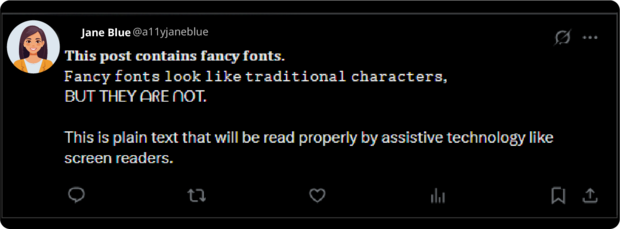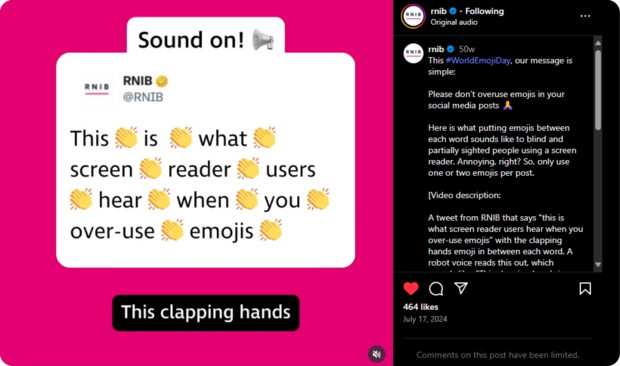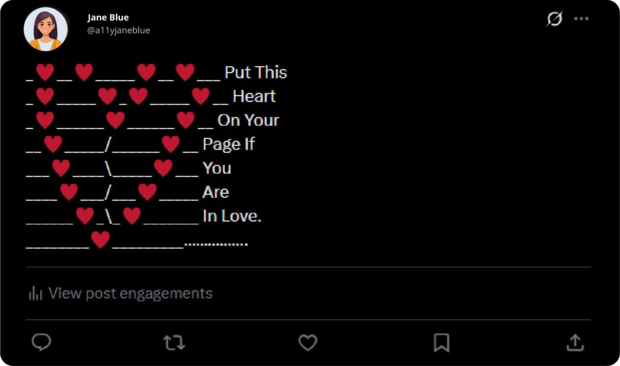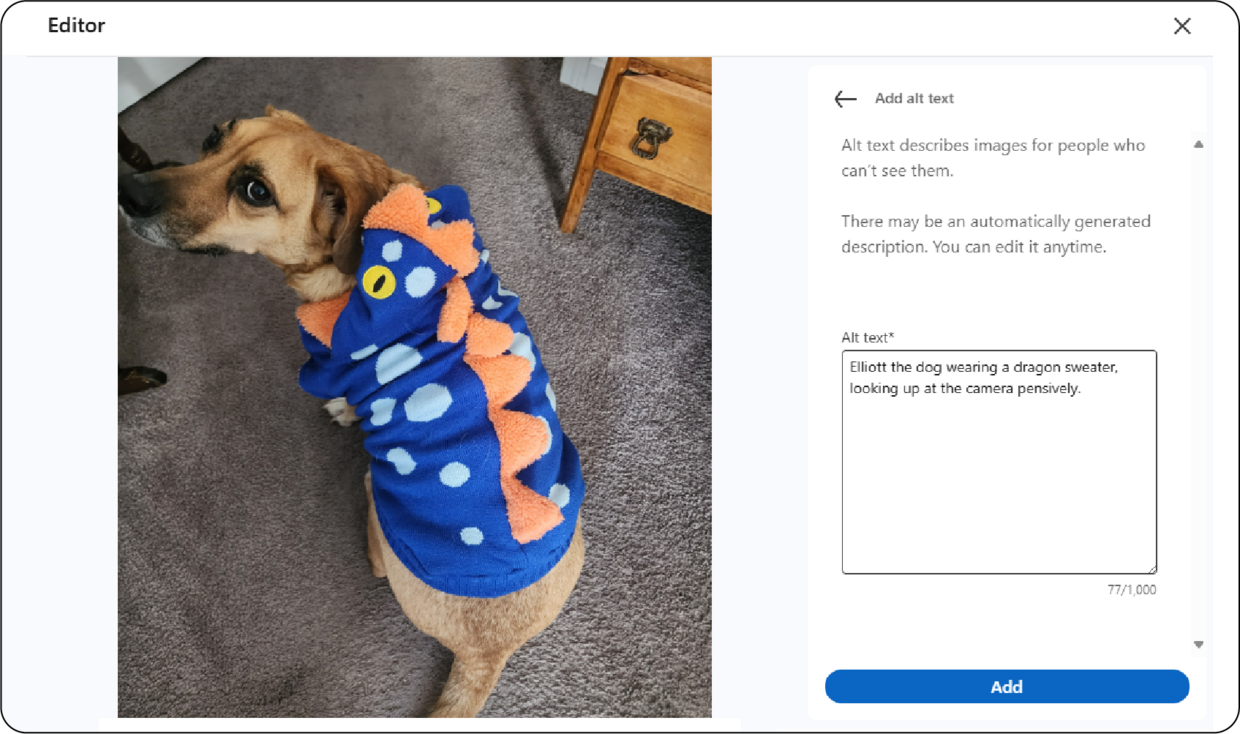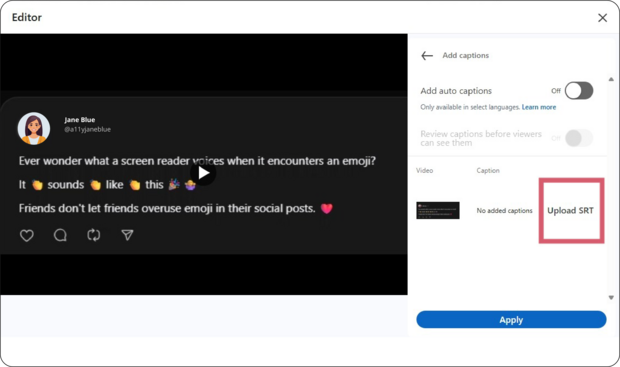Making social media posts accessible
Social media combines text with visuals and audio in a fast-paced, open forum for conversation, connection, and collaboration. For many, it’s the primary way to keep in touch with friends and family, share ideas, and find out about news and events. When our posts aren’t accessible it prevents people from participating and engaging with your content. Following these guidelines for social media post accessibility will ensure everyone is welcome to the conversation.
Requirements in brief
- Use plain language, avoid jargon and explain abbreviations.
- Avoid using non-standard characters, extra spaces, tabs, or hard returns to mimic text formatting.
- Avoid using ASCII art and excessive use of emoji.
- Format multi-word hashtags in #camelCase or #PascalCase.
- Add hyperlinks to the end of your post.
- Always include alt text or image descriptions when posting static images or GIFs.
- Any attached media, including static graphics, should adhere to color contrast and color use accessibility requirements.
- Avoid posting images or visuals with excessive text.
- Create videos with accessibility in mind, providing caption files or open captions and audio description or a transcript that includes visual-only content.
- When linking to video or audio, make sure there are captions, audio description, and transcripts available.
Text
Text is the primary modality in social media, whether you’re crafting a pithy post or responding to someone in the comments. In general, simple text with plain formatting is the most accessible and most understandable to your followers.
Plain language
We should all strive for plain language whenever we create text content for the public, and the same is true in social media where a conversational, active tone (external link) works best. Try to avoid industry jargon and buzzwords and explain terms that may be unfamiliar to followers. Spell out abbreviations when character limits allow. Use inclusive language that avoids biases and stereotypes.
Text formatting
Most social media platforms use a plain text field for authoring text content that typically uses standard characters for letters, numbers, and punctuation. This means that text formatting like bold, italics, and lists aren’t possible to achieve without using alternative characters (also called “fancy fonts”) or non-standard characters. Though these non-standard characters may visually appear like typical numbers or letters, they do not get interpreted in the same way or may be skipped entirely by assistive technology such as a screen reader.
Mimicking visual formatting with extra spaces, tabs, and hard returns can also be problematic, especially when they interrupt the typical flow of reading. Screen readers rely on spaces, punctuation, and hard returns to identify words, sentences, and paragraphs in your post. If these spaces fall in the middle of words to create a visual effect, it can cause confusion and a lot of frustration for followers who use assistive technology. Assume that your post will be read in the order the language dictates (for English and most other languages that use the Latin-script alphabet, that is left to right, top to bottom), spaces indicate new words, and paragraph returns indicate a new thought.
Emoji
Emoji, those little smiley faces and colorful symbols popular throughout social media and text messaging platforms, are a great way to convey an emotion or sentiment without adding more text to your post. They also contain their own text descriptions! If you choose to use emoji in your post, there are a few things to keep in mind:
- Use emoji sparingly and avoid repeating emoji several times in a row.
- Check Emojipedia (external link) for current text descriptions and variations by platform, browser, and device to ensure it doesn’t convey something you don’t intend.
- Avoid using emoji as formatting, such as in place of bullets in a list.
- Avoid using emoji as a replacement for a word in a sentence.
- Use emojis, not emoticons (e.g., a sideways smiley face created with a colon and a closed parentheses).
ASCII Art
ASCII (American Standard Code for Information Interchange) art is similar to an emoticon, because it uses characters and spacing to create an abstract illustration using text characters. As with emoticons, screen readers will not interpret the whole illustration but will read every character in the language order of the post. Best practice is to avoid using ASCII art and emoticons in your posts and save the illustrations for your attached media.
Hashtags
Hashtags are everywhere on social media, and they have many purposes. They can be used to include your post in topic searches, identify conversations, and are sometimes used as humor or to add context to your post. Because most hashtags can’t contain spaces or punctuation, multi-word hashtags often look and sound like a string of nonsense characters, or worse, can spell a word you didn’t intend. To avoid this, use camelCase or PascalCase in multi-word hashtags. By capitalizing the first letter in each word, it makes the hashtag easier to interpret visually, avoids confusion, and prompts assistive technology like screen readers to read the hashtag with the words intended and not words that the screen reader tries to interpret.
| Do: Use camelCase or PascalCase | Don't: Use lowercase only |
|---|---|
| #MyMassGov | #mymassgov |
| #camelCaseIsEasyToRead | #lowercaseishardertoread |
| #CapitalizeEachWordInYourHashtag | #wordsblendtogetherwithnocapitals |
| #DigitalAccessibility | #digitalaccessibility |
Overuse of hashtags can also be problematic and make your post harder to read. Limit hashtag use to three per post and add them at the end of your post copy. If you need to exceed three hashtags in your post, add them to the first comment of your post rather than the post copy.
Hyperlinks
Unlike websites and documents, it's not possible to create meaningful text links on social media platforms. For this reason, it's best practice to include any hyperlinks at the end of your post content so that truncated links or links that are long and contain a lot of characters can be skipped or stopped by those using screen readers without missing any content from your post.
Media
Whether you’re sharing a “We’re hiring!” graphic, a video message from the Secretary, or a podcast episode featuring your IT Director, both static and time-based media should follow accessibility guidelines.
Images and visuals
Images and visuals are essential in social media. Posts that contain graphics often get more impressions and engagement than text-only posts. When creating images and visuals for social media, make sure you’ve paid attention to color requirements, including sufficient color contrast for any text against the background of the image and avoiding using color alone to convey meaning.
As with all visual-only static content, images and visuals in social media require alternative text descriptions, also called alt text. But there’s one big difference about alt text in the social media context: There’s no way to mark an image as “decorative” in social media; all images posted to social media require alt text. Most popular social media platforms include the ability to add descriptions to your images. As a general rule, alt text should be short, concise, and no more than two sentences. However, if you encounter a platform that does not include this feature or the image requires a longer image description, consider adding that description to your post copy.
The practice of sharing images that contain a lot of text is very common in social media. Unfortunately, images of text are completely inaccessible to most assistive technology and contain too much information to include in alt text. If you’re posting a screenshot of a document or an infographic with a lot of text you expect your followers to read, consider linking to a webpage that contains an accessible text version in your post and using the alt text to provide a brief description. Avoid posting images of flyers or other documents made for print. Though there is no character or word limit on how much text you can have in your image, think of your image as a billboard rather than a document. Make every word count, and don’t forget to include those words in your description.
Many platforms also use artificial intelligence (AI) to include automatically generated alt text. GIFs often come with descriptions that have little to do with the content and more to do with the creator or subject of the GIF. Whether alt text was generated by AI or was attached to a visual from another source, always edit that alt text to fit your post’s purpose and context.
Alt text resources by platform
- Hootsuite: Edit your images in Hootsuite > Add alt text to images (external link)
- Facebook: Edit the alternative text for a photo (external link)
- Threads: Edit alt text for a photo before you share it (external link)
- Instagram: Why and how to add alt text to your Instagram posts (external link)
- LinkedIn: Add alternative text to images (external link)
- X:
- TikTok: Alternative text on photos (external link)
- Bluesky: Adding ALT Text to Your Images on Bluesky (external link)
Video and audio
Accessible video and audio begin with the planning process. When putting together your storyboard or script, try to avoid any visual-only content so you won’t need to add audio description. If you’re planning one of those popular style videos that use visual captions and music but no voiceover, consider adding a voiceover or including that information in a text description. If your video or audio file is long-form or contains essential information, include a link to a text transcript as well as language translation and sign language interpretation. Text transcripts that contain voiced content can make captioning much easier, as well. Planning for the accessibility of your shared media up front will save you time and effort when it’s time to post.
When you’re ready to post your video natively on a social platform, include a closed caption file or open captions burned into the video if the platform does not allow separate caption files. If you have a separate video with audio description, link to that version in your post. Finally, provide a video transcript that contains any visual-only information and identifies speakers either in your post copy, the description of the video, or link to this information on a webpage. You can also include a description of your video in your post copy. This can be helpful for shorter videos that don't typically have a webpage associated with them.
If you’re linking to an existing video or audio file, check the accessibility of that media before you post. For videos, make sure the video is captioned, contains audio description, and has a transcript. For audio, make sure a transcript is included.
Closed captioning resources by platform
- Hootsuite: Edit your videos in Hootsuite > Make your video content accessible (external link)
- Facebook: Add or remove captions on your video (external link)
- Threads/Instagram: Manage closed captions for your reels (external link)
- LinkedIn: Add closed captions to videos (external link)
- X: How to upload caption (.srt) file to Posts (external link)
- TikTok: Introducing auto captions (external link)
- Bluesky: How to Post Videos on Bluesky – with Subtitles (external link)
Live streaming
Live streaming on social platforms is like creating a mini event, and accessibility should be part of planning. For impromptu live streaming, take advantage of any automated accessibility enhancements, such as AI captioning, which is not ideal, but often better than no captions at all. For planned live streaming events, set up a live CART recorder to provide captions and instruct any participants or presenters to describe any visual content they share and arrange for sign language interpretation for large public events. When posting the archive of a live streamed event, consider creating a web page with all the essential information, including the captioned video and a transcript that contains speaker identification and a description of any visual-only information, and link to that page in your post.
